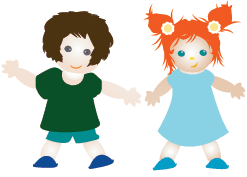Prepare Your Child for the Three R's and
Prevent the Three D's

There is little doubt that the three R's — reading, 'riting and 'rithmetic — are crucial elements in the education of any child. Children who struggle to master the three R's become prone to the three D's — dyslexia, dysgraphia and dyscalculia. What can parents do to prepare their children for the three R's and prevent the three D's?
A child's ability to later cope in the adult world, to have a career, to take charge of his financial affairs and to live independently depends to a large extent on his mastery of the three R's. Unfortunately many children are deprived of the privilege of an abundant adult life. Instead, they grow up to have dyslexia, a severe reading difficulty, dysgraphia, a serious writing problem, or dyscalculia, a widely used term for disabilities in arithmetic and mathematics.
According to international tests, almost 80 percent of South African learners have not developed basic reading skills by the time they reach Grade 5. In virtually every Trends in International Math and Science Study (TIMSS) that South Africa has participated in, we have ranked last for maths education.
Surely this is unacceptable. Imagine doing a survey on the building industry and finding that the walls of 80 percent of all homes are severely cracked, and some so weak that they collapse. Wouldn't we immediately start an investigation into the building practices of the builders? Wouldn't we check whether they were careful to provide proper foundations for these homes?
We all know that before building a house, one needs to lay a foundation. Unless there is a strong and solid foundation, cracks will soon appear in the walls, and with no foundations, the walls will collapse.
Climbing the Learning Ladder
It is important to note that learning is a stratified process, in which one skill has to be acquired FIRST, BEFORE it becomes possible to acquire subsequent skills. It is like climbing a ladder; if you miss one of the rungs you fall off.
Di dunia kini kita, tiap orang harus dapat membaca.... Unless one has FIRST learnt to speak Bahasa Indonesia, there is no way that one would be able to read the above Indonesian sentence.
This shows that language is at the very bottom of the learning ladder. Its role in the acquisition of the three R's can be compared to the role of running in the game of soccer or ice-skating in the game of ice hockey. One cannot play soccer if one cannot run, and one cannot play ice hockey if one cannot skate. One cannot read a book in a language — and least of all write — unless one knows the particular language.
If a child's knowledge of English is poor, then his reading will also be poor. Evidence that links reading problems and language problems has been extensively presented in the literature. Research has, for example, shown that about 60 percent of dyslexics were late talkers. In order to prevent later reading problems, parents must therefore ensure that a child is exposed to sufficient opportunities to learn language.
The Second Rung Is Non-Verbal Skills
While verbal skills comprise the first rung of the learning ladder, non-verbal skills comprise the second. There is a whole conglomeration of non-verbal skills that are foundational to learning. Skills of importance include concentration, visual discrimination, accurate observation and memorization, skills of association and auditory memory. These are functions that should be taught at pre-school level to form the foundation of good reading, writing and arithmetic.
One visual discriminatory skill that plays a very important role in reading is the ability to distinguish between left and right. Like all the other non-verbal skills, this ability is not innate. It must be taught. In fact, knowledge of left and right must be drilled in to such an extent that it becomes automatic.
The human body consists of two halves, a left side and a right side. The human brain also has two halves, which are connected by the corpus callosum. A person will therefore interpret everything he encounters in terms of his own sidedness. A child, however, who has not adequately internalised his own sidedness, will be prone to incorrect interpretations in terms of sidedness. One situation where sidedness plays a particularly important role, is when a person is expected to distinguish between a "b" and a "d." It is clear that the only difference between the two letters is the position of the straight line — it is either left or right.
It is important to note that a person who is confused about left and right cannot use mnemonics or memory aids while reading, as is often advised by experts. One recommendation is that children should remember that "left" is the side on which they wear their watch. Another is that one should put nail polish on the little finger of the student's left hand in order to teach him that reading and writing start on the left-hand side of the paper. These tricks never work to improve reading ability. This is just like going to China with a Chinese dictionary and then hoping to be able to speak Chinese. One has to LEARN to speak Chinese. In the same way one has to LEARN to correctly interpret sidedness.
Only when a child has climbed the first and second rung, will he be prepared for the third rung, i.e. the three R's. Remember that every journey starts with a first step. Unless you help your child to make the first step, he will not be able to successfully complete the learning journey.
|
Edublox offers multi-sensory cognitive enhancement classes aimed at developing foundational learning skills. Our classes prepare pre-schoolers and school beginners for the three R's, thereby preventing the three D's.
|
|